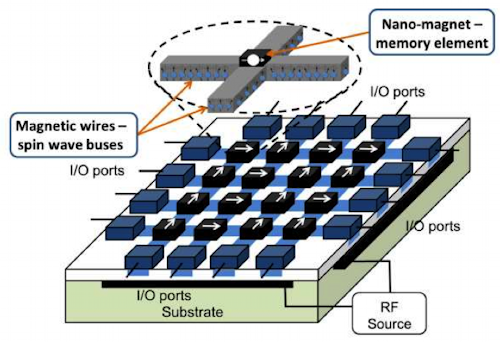Introducing an irregular series on speculative storage technologies. StorageMojo likes emerging technologies, but these are still gestating and may never emerge. Magnetic holography is first.
Optical holography has gotten lots of funding over the years – most recently with $100m for InPhase – but holography isn’t limited to optical. Holography is the storage of information in the wave interference pattern produced by two beams, one that bounces physically or virtually off whatever we seek to record and the second coherent background.
Acoustic holograms are used in seismic; microwave holograms in radar. Now, magnetic holography, in a paper by F. Gertz, and A. Khitun of UC Riverside and A. Kozhevnikov and Y. Filimonov of the Kotel’nikov Institute of the Russian Academy of Sciences. Their paper Magnonic Holographic Memory (pdf) describes a solid-state device they’ve fabricated that uses spin wave interference to store data.
A spin wave is
. . . a collective excitation due to oscillation of electron spins in a magnetic lattice. Similar to phonons (lattice vibrational waves) spin wave propagation occurs in magnetic lattices where spins are coupled to each other via the exchange and dipole- dipole interactions and a quantized spin wave is referred to by a quasiparticle called a magnon.
Got that?
It is a subset of spintronics with some attractive properties: longer coherence, i.e. multiple coupled spins that are more robust than single spin; and, operational at room temperature. These devices can be fabricated using semiconductor methods, though much remains to be done to achieve a commercial device.
Conceptually the device reminds me of acoustic mercury delay lines – a very early type of digital storage – in that the information propagates through the magnetic matrix and is read on the other side. Longer-term storage requires refreshing the signal, but there looks to be a possible ultra-low power technique.
The authors have fabricated a two bit device and tested it. They believe it can be scaled down into nanometer devices to achieve storage densities of 1Tb/cm2. Here’s a diagram of the device from the paper:

The StorageMojo take
Semiconductor magnetic media? Not your father’s disk drive – or this generation’s NAND flash. This is basic research, not product development, but it points out that there’s more than one way to do holography and magnetic storage.
While Seagate and WD are making progress on much higher density disk storage, it is evident that the days of 40% annual increases in areal density are behind us. It’s good to know that there may other ways to create ultra-dense storage.
Courteous comments welcome, of course. This is the 2nd interesting storage physics paper I’ve seen from UC Riverside. Keep up the good work!


Recent Comments